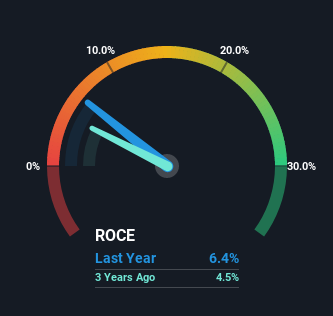- United States
- /
- Basic Materials
- /
- NYSE:SUM
Investors Met With Slowing Returns on Capital At Summit Materials (NYSE:SUM)
If we want to find a stock that could multiply over the long term, what are the underlying trends we should look for? Ideally, a business will show two trends; firstly a growing return on capital employed (ROCE) and secondly, an increasing amount of capital employed. Ultimately, this demonstrates that it's a business that is reinvesting profits at increasing rates of return. In light of that, when we looked at Summit Materials (NYSE:SUM) and its ROCE trend, we weren't exactly thrilled.
What Is Return On Capital Employed (ROCE)?
For those that aren't sure what ROCE is, it measures the amount of pre-tax profits a company can generate from the capital employed in its business. Analysts use this formula to calculate it for Summit Materials:
Return on Capital Employed = Earnings Before Interest and Tax (EBIT) ÷ (Total Assets - Current Liabilities)
0.064 = US$255m ÷ (US$4.3b - US$333m) (Based on the trailing twelve months to July 2022).
Thus, Summit Materials has an ROCE of 6.4%. Ultimately, that's a low return and it under-performs the Basic Materials industry average of 9.4%.
Check out our latest analysis for Summit Materials

In the above chart we have measured Summit Materials' prior ROCE against its prior performance, but the future is arguably more important. If you'd like, you can check out the forecasts from the analysts covering Summit Materials here for free.
What The Trend Of ROCE Can Tell Us
The returns on capital haven't changed much for Summit Materials in recent years. Over the past five years, ROCE has remained relatively flat at around 6.4% and the business has deployed 28% more capital into its operations. Given the company has increased the amount of capital employed, it appears the investments that have been made simply don't provide a high return on capital.
The Bottom Line
Long story short, while Summit Materials has been reinvesting its capital, the returns that it's generating haven't increased. Since the stock has declined 24% over the last five years, investors may not be too optimistic on this trend improving either. In any case, the stock doesn't have these traits of a multi-bagger discussed above, so if that's what you're looking for, we think you'd have more luck elsewhere.
Summit Materials does have some risks, we noticed 3 warning signs (and 2 which are significant) we think you should know about.
If you want to search for solid companies with great earnings, check out this free list of companies with good balance sheets and impressive returns on equity.
New: Manage All Your Stock Portfolios in One Place
We've created the ultimate portfolio companion for stock investors, and it's free.
• Connect an unlimited number of Portfolios and see your total in one currency
• Be alerted to new Warning Signs or Risks via email or mobile
• Track the Fair Value of your stocks
Have feedback on this article? Concerned about the content? Get in touch with us directly. Alternatively, email editorial-team (at) simplywallst.com.
This article by Simply Wall St is general in nature. We provide commentary based on historical data and analyst forecasts only using an unbiased methodology and our articles are not intended to be financial advice. It does not constitute a recommendation to buy or sell any stock, and does not take account of your objectives, or your financial situation. We aim to bring you long-term focused analysis driven by fundamental data. Note that our analysis may not factor in the latest price-sensitive company announcements or qualitative material. Simply Wall St has no position in any stocks mentioned.
About NYSE:SUM
Summit Materials
Operates as a vertically integrated construction materials company in the United States and Canada.
Moderate growth potential low.
Similar Companies
Market Insights
Community Narratives



